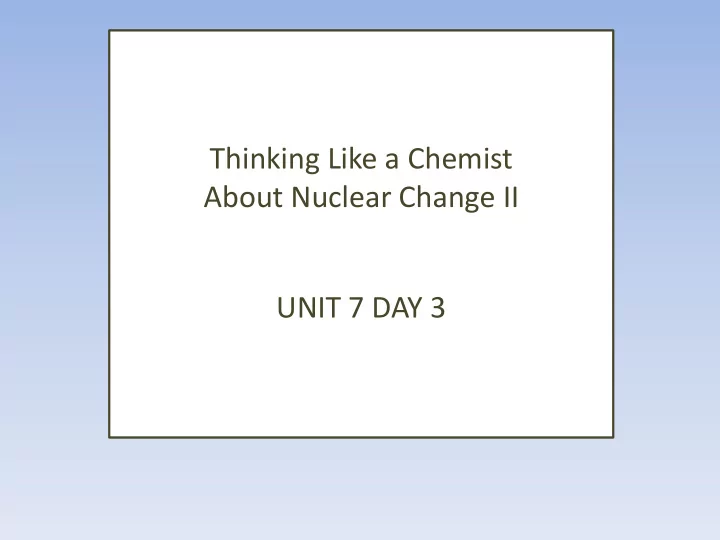

Thinking Like a Chemist About Nuclear Change II UNIT 7 DAY 3
What are we going to learn today? Isotopic Stability Ionizing Radiation
QUIZ: Clicker Question The following is an example of: 11 Na 22 22 10 Ne + 0 1 e a) Fission b) Fusion c) Alpha decay d) Beta decay e) positron decay
POLL: CLICKER QUESTION What is nuclear radiation? A. High energy electrons B. High energy small nuclei C. high energy electromagnetic radiation D. A & B E. all of the above
Three basic types of nuclear radiation alpha radiation positive and massive beta radiation negative and low mass gamma radiation uncharged (no mass) Radioactivity – the spontaneous emission of radiation by certain isotopes of certain elements - Madame Curie
Where does radiation come from? • Unstable radioisotopes – Naturally found in environment – Made by humans for medical, energy, defense purposes
Radioactive Decay – just happens
WORKSHEET: Continuing activity from last class. Start with #5. In the first equation and on the chart: Rn should have an atomic number of 86 and Po has an atomic number of 84. Mass numbers are correct. 86 Rn 211 215 84 Po + 4 2 He
Plot of Neutrons vs Protons
Band of Stability http://www-nds.iaea.org/relnsd/vcharthtml/VChartHTML.html DISCOVER THE TYPES OF RADIATION THAT SHOULD OCCUR FOR EACH PART OF GRAPH
Radioactive Decay – Band of Stability
Three basic types of nuclear radiation alpha radiation positive and massive beta radiation negative and low mass gamma radiation uncharged (no mass) Radioactivity – the spontaneous emission of radiation by certain isotopes of certain elements - Madame Curie
Effects Are Different
Alpha Particles • INSIDE BODY = HARMFUL – bare Helium nucleus will rip electrons off molecules – ionization of biomolecules = unhealthy you • Generally not harmful as they are absorbed by your outer layer of dead skin – (bad news if they get in your lungs!) • http://www.epa.gov/rpdweb00/understand/al pha.html#affecthealth
Beta Decay
Gamma Rays • This is what will do you in. • Hard to protect against. Highly ionizing. • Like the world’s worst sunburn (except the radiation can penetrate skin) • http://www.epa.gov/rpdweb00/understand/g amma.html#affecthealth
RADIOACTIVITY DEMO KCl salt: K-40, g Lantern mantle: Th-232 and daughters, a b g Monazite Rock: Th-232 and daughters, a b g Demo Button 1: Cs-137, g Demo Button 2: Ra-226, g
POLL: Clicker Question A Geiger counter shows that a sample is emitting radiation. Placing a piece of paper or wood between the sample and the device does not diminish the counts, but placing a piece of lead between the sample and device stops the detection of radiation. What type of radiation is being emitted? A. α B. β C. γ
What did we learn today? Isotopic Stability Depends on Neutron to Proton Ratio Decay “Particles” – Ionizing Radiation alpha beta gamma positron
IMPORTANT INFORMATION LM 26 HW 8
Recommend
More recommend